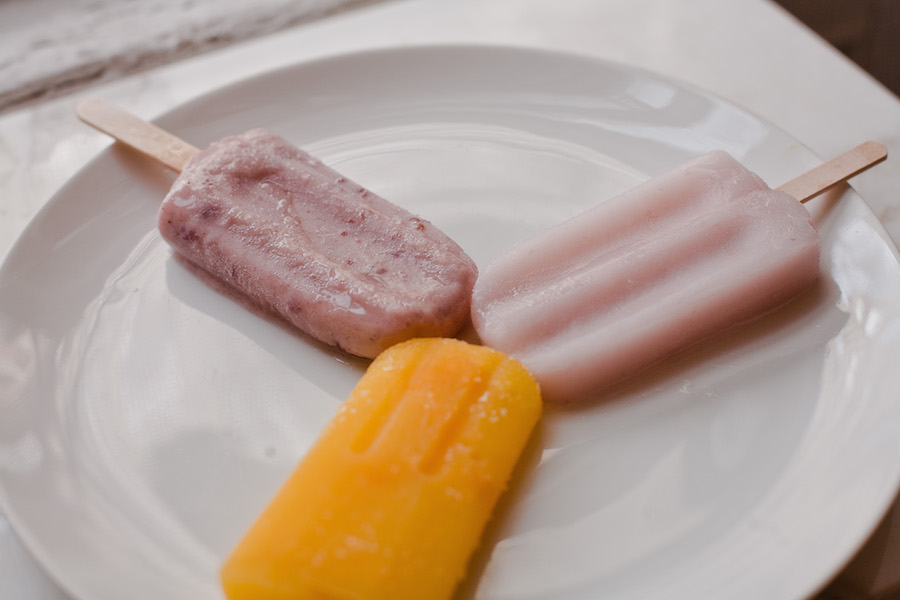Smooth and white, creamy and comforting—all adjectives for the foods that have kept us company from childhood, in cold weather or hot. Makes you scream for cow? Not if you’re one of the 1,339,724,852 people living in China (not to mention the Chinese in other countries).
There is, curiously, no dairy in the Chinese diet (no, the “genetically can’t digest milk” argument has been out on its ear for at least 20 years, according to food historian Anne Mendelson). Yet the Chinese have comforting, homey flavors equal to ours. Do they know something that we—the lactose-tolerant or -intolerant— don’t? To answer that question, your writer started digging—a hole to China, that is—and accidentally hit the N train tunnel, which led straight to Sunset Park, Brooklyn’s Chinatown. There, some favorite treats were waiting, remembered from childhood (one which was spent straddling both cultures). They fit the “dairy” bill in every way except on the moo-meter. So here’s an offbeat guide. Bring your taste for the familiar—just expect to find it in a less familiar form.
SMOOTH AND COMFORTING: Think oatmeal. Think grits. Think white. This is juk. Made from rice and a liquid (water or chicken broth), the ingredients are simmered until they become smooth and thick. The result can be neutral, savory or sweet—it depends on what you add—and it feels great sliding down your throat. C & L of East Ocean Restaurant (5304 Eighth Avenue; 718.438.6668) has two enormous ceramic pots in the window, which hold traditional soups. This lends an authentic aura to the place, as does the restaurant’s Chinese name: “Old Fu Zhou,” the capital city of Fujian Province. Five kinds of juk are offered here: plain white, or white with scallion greens, pumpkin, aduki beans or shredded meat. Take one, then move to the spread of condiments—fried egg, fish slices, chopped greens, sweet beans, seaweed. Eat in or take out. There’s an unusual dish here: peanut broth soup. It’s the color of fog, and its taste is nothing like what you’ve had between two slices of bread. At the bottom are boiled peanuts as tender as potatoes. What a match for your child’s grilled cheese! Every kid loves peanuts, but this is continents away from Skippy. C & L serves these foods in the morning. Don’t go looking for them after lunch.
WARM AND CREAMY: Taste Good Soya Food (5103 Eighth Avenue; 718.633.3913) is a small dofu manufacturer operating out of a storefront that closes at 5:50 p.m. This is important to remember because you want to pick up dofu hua for dessert on your way home. Plan your day accordingly. “Dofu hua” means “flower of bean curd,” and it’s so soft that it quivers. This creamy custard is always sold with sugar syrup, which you pour over it, then devour. My preference is to take it home and pour pure maple syrup on it. Heaven. Buy two (you might need extra).
COOL AND TASTY: Have you ever noticed how there’s always an ice cream shop in Chinatown doing a land-office business summer or winter? Iced treats are a Western-inspired addition to Chinese snacking (along with freezers). The ice creams of the cow kind are not on our menu, but popsicles sold in Chinese supermarkets are. No chocolate-vanilla-strawberry empire here—it’s tropical fruits that spell sweetness for the Oriental palate. (Check the ingredients to make sure there’s no milk powder or cream.) These three passed the milk-free test: Mango (Shui Mei, Taiwan) is fruity but not too sweet. A refreshing end to a winter meal. Red Bean (Cremo, Thailand) is made with coconut milk. The tasting team fought over this one. Its honeydew fragrance has a hint of coconut. Taro (Sweety, USA)—chefs take note: This is neutral in an interesting way, and barely sweet. A perfect palate cleanser between courses. Ditch the stick and serve it at your next dinner party. Good popsicle selections at Fei Long Market (6301 Eighth Ave.; 718.680.0118). Also at Seaport Seafood and Meat Market (5707 Eighth Avenue; 718.436.3288). Not cowed anymore?
Editor’s note: East Ocean Restaurant has closed.
Mandarin for “yum.” Dishes like bean curd custard and creamy juk are well worth a ride on the N.
Photo credit: Noah Devereaux
Story by Valerie Saint-Rossy



